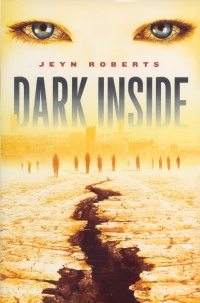| ________________
CM . . . . Volume XVIII Number 19 . . . . January 20, 2012

 |
Dark Inside.
Jeyn Roberts.
New York, NY: Simon & Schuster BFYR (Distributed in Canada by Simon & Schuster Canada),
329 pp., hardcover, $19.99.
ISBN 978-1-4424-2351-0.
Subject Headings:
Science fiction.
Survival-Fiction.
Monsters-Fiction.
Good and evil-Fiction.
Grades 7-11 / Ages 12-16.
Review by Karen Boyd.
*** /4
|
| |
|

excerpt:
They are the things that hide in your closet and fuel your fear. They lurk in both alleyways and living rooms. They sit across from you at restaurants and push past you to ride the bus.
They are the dark thoughts inside of us we pretend we don’t hear. We ignored them but they didn’t go away. They grew stronger. Louder. They began to make sense.
High school-aged Aries, Mason, Clementine, and Michael are each separately finding a way to survive in a very changed world. Following extreme terrorist attacks and earthquakes, the order of civilization has fallen apart. Each teenager has lost parents either through death or separation and now must decide whom they can trust. Places of safety, such as home or school, have become traps and places of death. Neighbours that they would have turned to for help are now dragging women and children out of their beds to beat them to death on the street. The loss of all the systems and technology that helped them to get through the day has forced them to survive in ways that they couldn’t have imagined. There is no way to know who might be “changed” and want to kill them.
While Zombies and Vampires may be terrifying, they pale in comparison to the humans in Dark Inside. Redefining what we mean by humanity, Roberts considers that being human means being evil. When unexplainable events sweep the veneer of social function from most humans, what is left is a population cannibalizing itself through violence, murder, and torture. Those that have embraced their evil side are referred to as “baggers”, a reference to hunters who bag their prey.
Each chapter in Dark Inside is written from the perspective of one of the teenagers. These chapters are interspersed by chapters written by “nothing”. The identity of “nothing” is alluded to throughout the text but left to the meaning-making of the reader. Roberts also includes the mysterious Daniel. Daniel does not receive his own chapters to tell his story, unless he is “nothing”. Nonetheless, Daniel is invested in each of the characters and seems to appear when most needed. As the characters move toward each other from different places, it is Daniel who shows them that they do have strength and can fight back. It is debatable as to whether the book ends on a hopeful or a futile note. While the characters find strength, the enormity of the destruction makes one wonder if there can be hope for the future.
One of the strengths of Robert’s writing is that readers are kept on their toes in a similar way that the characters in the story are in a state of anxiety. The reader doesn’t really know whom to trust, whom to believe. Each of the characters could just as easily turn into one of the “baggers”, and, in fact, based on the words of Nothing, may have already done so. The language in Dark Inside is stark and graphically violent. While reading, I found myself holding my breath and struggling not to look away from the text. Having said that, weeks later I still find myself thinking and talking about this book.
Roberts has written a horrifying page-turner which is not for the faint of heart. While many other scary books can be rationalized by saying, “There are no such things as monsters”, it is far more difficult to deny that humans have a dark side. Robert’s novel sticks with you and encourages the reader to ask some hard questions: What makes us human? How do we control our behaviour? Why do we control it? Would we be able to control our true “humanity” without the external forces that we take for granted?
Recommended.
Karen Boyd is a doctoral candidate in language and literacy and an instructor in the bachelor of education program at the University of Manitoba.

To comment
on this title or this review, send mail to cm@umanitoba.ca.
Copyright © the Manitoba Library Association. Reproduction for personal
use is permitted only if this copyright notice is maintained. Any
other reproduction is prohibited without permission.
NEXT REVIEW |
TABLE OF CONTENTS FOR THIS ISSUE
- January 20, 2012.
AUTHORS |
TITLES |
MEDIA REVIEWS |
PROFILES |
BACK ISSUES |
SEARCH |
CMARCHIVE |
HOME |
